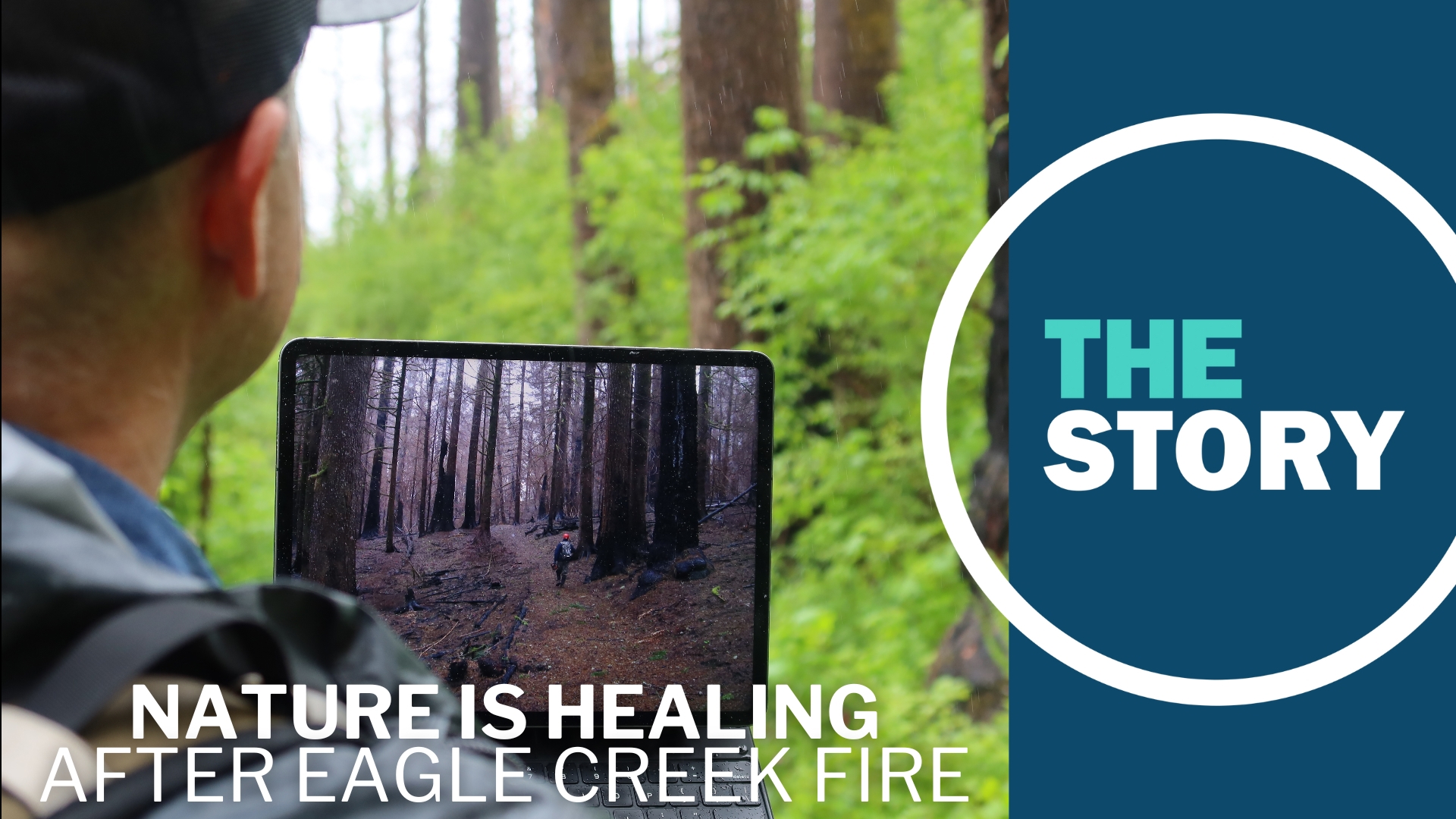PORTLAND, Ore. —
High above Multnomah Falls, in the upper reaches of the Columbia River Gorge, Ralph Bloemers is on a reconnaissance mission.
Armed with an iPad and hundreds of photos, Bloemers positions himself carefully, lining up the iPad’s camera to match a photo taken six years prior.
The old photo, taken in 2017, is all browns and blacks. A barren forest floor is coated in ash, punctuated only by charred tree trunks, scorched by the Eagle Creek Fire.
The new photo, taken in early June, is awash in infinite shades of green — with ferns, lupine and fireweed growing above head height, and even the blackened trunks of some of the larger conifers show signs of new growth.
“It’s coming back, it’s fierce,” said Bloemers, director of fire safe communities for Green Oregon. “It’s almost hard to believe it's the same location.”
Pull the slider left and right on the photo below to compare what the forest looked like after the fire and what it looks like in 2024.
Every year since the fire, Bloemers has been returning to select locations in the Gorge to document nature’s recovery, at the same time working to change the narrative around large fires.
“Since the Eagle Creek fire in ‘17, I’ve been running wildlife, time-lapse and aerial photography to see the life in here, the regrowth, the wildlife, the stuff that we don’t see that’s happening when we’re not here,” he said. “To try to have that tell a story for people about how big hot fires work in our forests and how the forest comes back after them.”
To get all the “before” pictures, Bloemers connected with folks from the U.S. Forest Service and Trail Keepers of Oregon as they were doing trail surveys in the immediate aftermath of the fire.
“I got probably close to 100 photos,” he said. “I went on a treasure hunt to find all those exact locations and I GPS marked them. Then I go back, and I stand at the exact same location, and I do matching pairs.”
Bloemers explained that forests like those that grow in the Gorge have evolved over thousands of years to coexist with fire.
When the dense canopy burned, it opened up the forest so sunlight could penetrate to the forest floor.
“This was a severely burned patch, but that just means huge amounts of sunlight for the forest floor and all kinds of plants before that weren’t getting enough sunlight that were in the seed bed, that were in the ground, are all of a sudden like, ‘it’s my turn,’” he said.
And even some of the largest trees — Douglas fir, oak, hemlock and maple — have adapted to fire.
“Its got really thick bark, and when it burned all it did was char around that tree,” Bloemers said pointing to a tall Douglas fir. “The entire circumference of the tree at the base can be burned and charred, but if we scratched underneath that it would be live, and the cambium is still alive.”
The canopy on some of those firs has begun to regrow. Others are showing epicormic regrowth, when the tree sprouts needles from the middle of its limbs, giving the tree an almost wooly look.
For the hardwoods, Bloemers noted that the main trunk can fully burn, but the root system often remains intact.
“Right after the fire this was completely burned off,” Bloemers said, looking at the scorched trunk of a maple tree. “Now it's a jungle. Now there’s hardwoods resprouting from the base.”
It’s not just the plant life, either. In addition to the picture matches and the time-lapse cameras Bloemers runs, he also maintains a network of trail cameras.
“I’ve gotten bear, cougar, elk,” he said. “I’ve gotten grouse fighting and jousting in the fall and in the spring. I’ve gotten all kinds of buck and does and does with fawns.”
The fauna that lives in the Gorge never really went away, Bloemers said, and in fact he said he captured more pictures in the months after the fire, before humans returned to the area.
Bloemers first became interested more than 20 years ago when he accompanied a friend on a controlled burn. It wasn’t at all what he expected.
“I thought fire destroyed landscapes and that they were black and burned and they weren't going to be very interesting,” he said. “And what I found was just the opposite. There's lot of noise, a lot of wildlife, a lot of new things to see.”
Since then, he’s sought to change the narrative around wildfires, noting that fire has existed in the forests of the Pacific Northwest for as long as the forests themselves have been around.
Fires can be tragic, of course, when homes are destroyed or lives are lost, but Bloemers said that when people and property are safe, wildfires can be hugely beneficial and, in fact, necessary.
“We're trying to make this transition in our society of living better with fire while protecting our communities,” he said.
And that will require holding seemingly contradictory beliefs simultaneously.
“Fire is a destroyer when it burns a house, but out here, fire is not really a destroyer, at least not on a permanent level,” he said. “It temporarily burns vegetation and then that vegetation comes back. So we have to kind of be able to hold those two countervailing ideas in our heads.”
He likened the emerging growth in the Gorge to that of an adolescent.
“A burnt landscape is like a young person that's full of life and potential,” he said. “You don't know what direction it's going to go. It's sprouting up. It's awkward. It's noisy like a teenager. And so there's a lot to see.”

